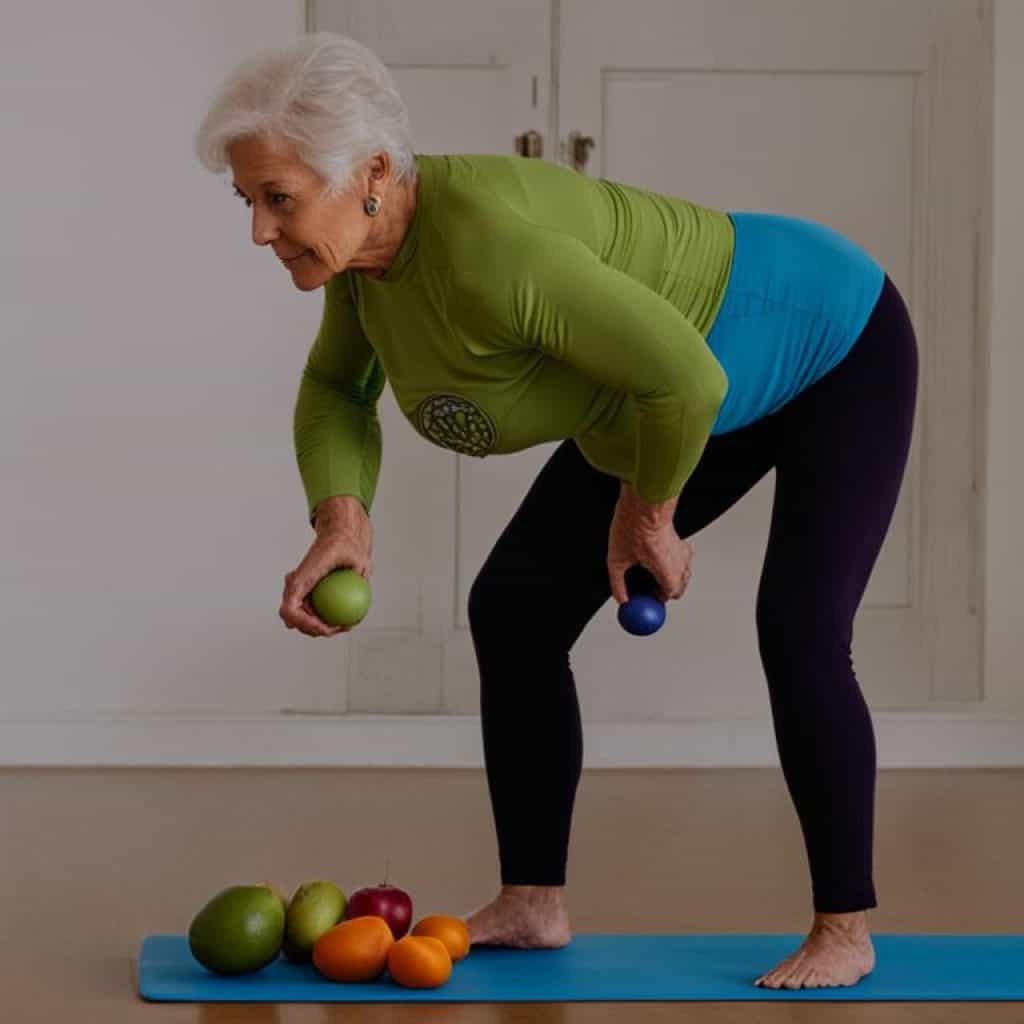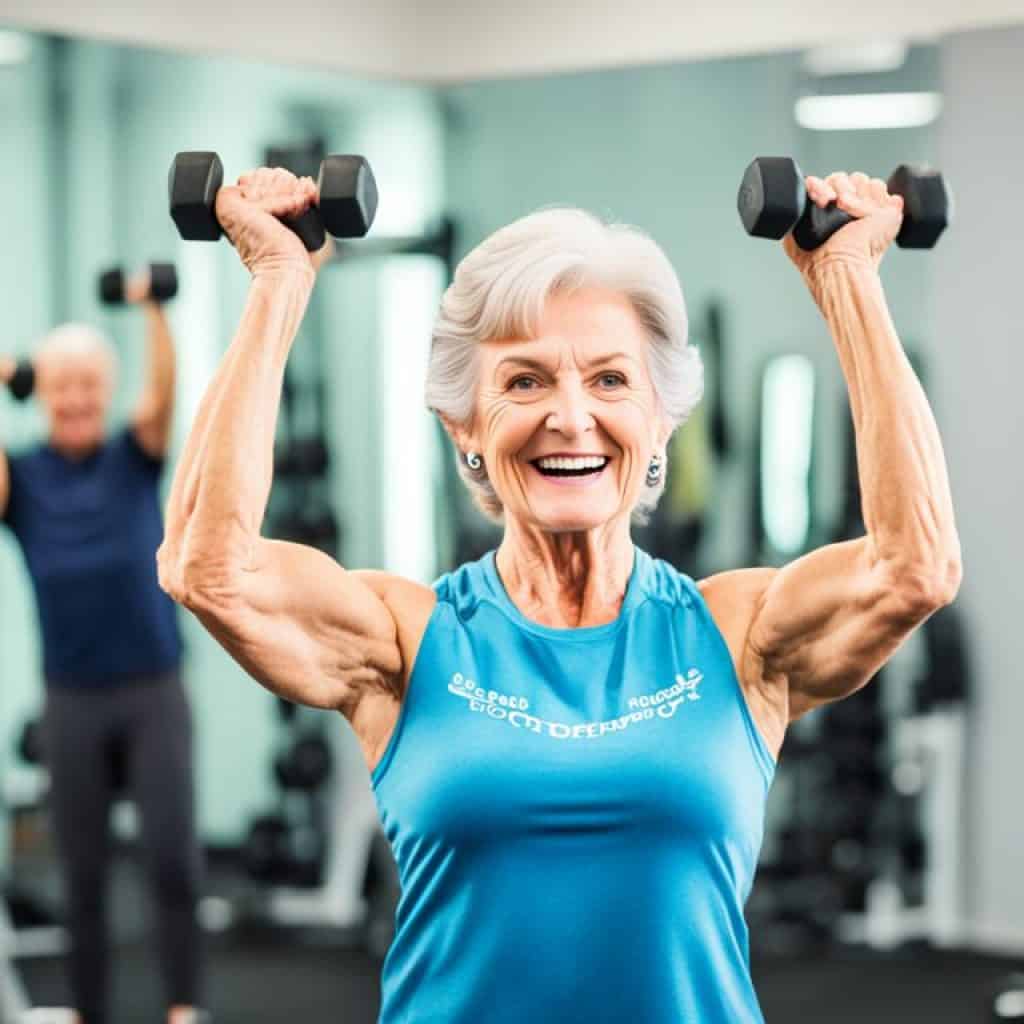Turning 50 is a milestone that comes with its own set of challenges and opportunities. As we age, our bodies change, and staying in shape becomes a priority for overall health and well-being. But getting fit at 50 is not just about physicality; it’s about embracing a fulfilling life that is marked by vitality, strength, and confidence.
Like many others, I found myself at a crossroads when I hit my 50s. My energy levels were lower, and I noticed a decline in my overall fitness. However, I realized that it was never too late to make a change and invest in my health. This realization became my motivation to embark on a journey of getting fit and reclaiming my vitality.
Through my own experiences and research, I have discovered that getting in shape at 50 is not only achievable but can also be incredibly rewarding. It’s about finding the right exercises that nourish your body and soul, embracing a healthy lifestyle, and adapting to the changes that come with aging.
In this article, I will share with you 6 top tips for getting fit later in life. These tips, backed by scientific research and real-life experiences, will empower you to take control of your fitness journey and unlock your full potential at 50 and beyond.
Key Takeaways:
- Getting fit at 50 is a personal journey that can bring immense joy and fulfillment.
- Embrace the changes that come with aging and adapt your fitness routine accordingly.
- Find exercises that you enjoy and make them a regular part of your routine.
- Gradually increase the intensity and duration of your workouts to avoid injuries and burnout.
- Exercise with friends or join groups for extra motivation and support.
Find an Exercise You Love
Finding an exercise that you love and enjoy is crucial for sticking to a fitness routine. It’s important to engage in activities that not only benefit your physical health but also bring you joy and satisfaction. By discovering an exercise that resonates with you, you are more likely to make it a regular part of your routine and stay committed to your fitness goals.
For seniors, there are various exercise options that cater specifically to their needs. Here are some examples of workout routines for older adults:
- Running: Running is a versatile exercise that can be adjusted to suit your fitness level. It helps improve cardiovascular health and endurance. Remember to start at a comfortable pace and gradually increase the distance or intensity.
- Walking: Walking is a low-impact exercise that can be easily incorporated into your daily routine. It aids in maintaining joint mobility, increasing stamina, and promoting overall fitness.
- Swimming: Swimming is a fantastic exercise for seniors as it puts minimal stress on the joints while providing a full-body workout. It helps improve cardiovascular health, builds muscle strength, and enhances flexibility.
- Cycling: Cycling is a non-weight bearing activity that is gentle on the joints. It is beneficial for cardiovascular health, leg strength, and balance. You can cycle outdoors or use a stationary bike indoors.
- Joining Exercise Classes: Many fitness centers and community centers offer exercise classes specifically designed for seniors. These classes may include activities such as yoga, Pilates, tai chi, or aerobics. They provide a structured and supportive environment to stay active and meet like-minded individuals.
Remember, it’s essential to choose an exercise that suits your abilities and preferences. This will make your fitness journey enjoyable and sustainable in the long run. Consult with a fitness professional or your healthcare provider to determine a workout routine that caters to your individual needs and goals.
The table below highlights the benefits of different exercise options for seniors:
| Exercise | Benefits |
|---|---|
| Running | Improved cardiovascular health and endurance Strengthened leg muscles and bones |
| Walking | Increased stamina and energy Enhanced joint flexibility and mobility |
| Swimming | Low-impact exercise for overall fitness Improvement in cardiovascular health, strength, and flexibility |
| Cycling | Improvement in cardiovascular health Strengthening of leg muscles without placing stress on joints |
| Exercise Classes | Structured and supportive environment Opportunity to meet like-minded individuals Benefits of various exercises tailored for seniors |
Build Up Exercise Gradually
When it comes to staying active at 50 and maintaining a healthy lifestyle for aging adults, it’s important to approach your exercise routine with caution and build it up gradually. Whether you are just starting or returning to exercise after a long break, taking it slow will help prevent injuries and burnout, ensuring a sustainable fitness journey.
Starting with shorter durations and lower intensity exercises will allow your body to get accustomed to physical activity without overwhelming it. This approach is especially crucial as our bodies change with age, and it may take longer to recover from intense workouts. By gradually increasing the duration and intensity of your exercises, you give your body time to adapt and strengthen.
Remember, slow and steady wins the race!
By taking the time to build up your exercise routine gradually, you’ll lay a solid foundation for continued progress and success. Consistency is key in maintaining a healthy lifestyle, and it’s better to start small and gradually increase your efforts rather than pushing yourself too hard too soon and risking setbacks.
“It does not matter how slowly you go as long as you do not stop.” – Confucius
Embracing a gradual approach to exercise is not just about physical well-being; it’s also about the mental and emotional benefits that come with it. When you give your body the time it needs to adapt and grow stronger, you’ll feel a sense of accomplishment and be more motivated to continue on your fitness journey.
Key Benefits of Building Up Exercise Gradually:
- Reduces the risk of injuries
- Prevents burnout and fatigue
- Allows time for the body to adapt and strengthen
- Enhances long-term progress and sustainability
- Boosts motivation and sense of accomplishment
By gradually building up your exercise routine, you’ll be setting yourself up for a successful and enjoyable fitness journey as you age. Remember to listen to your body, be patient with yourself, and celebrate every milestone along the way.
Exercise With Friends or Groups
Exercising with friends or joining exercise groups can be a game-changer when it comes to staying active and motivated. Not only does it make your workouts more enjoyable, but it also provides a support system and accountability that can help you stay consistent with your fitness routine. Whether you’re looking to spice up your exercise routine or seeking like-minded individuals to accompany you on your fitness journey, exercising with friends or groups can be the perfect solution.
When you exercise with friends, it creates a social atmosphere that can make your workouts feel like less of a chore. The camaraderie and friendly competition can push you to challenge yourself and reach new fitness heights. Plus, it’s a great opportunity to catch up, have conversations, and strengthen bonds while getting fit together.
Joining exercise groups or clubs specifically designed for seniors can provide additional benefits. These groups often offer tailored activities that cater to different fitness levels and interests, ensuring that you find an exercise that suits your preferences. Whether it’s a walking group, a dance class, or a team sport, the options are diverse and cater to various interests and abilities.
Add a touch of adventure to your exercise routine by exploring new places with your fitness buddies. Plan hikes, bike rides, or group excursions that allow you to enjoy the outdoors and discover scenic routes while staying active. This not only keeps things interesting but also provides a change of scenery and a breath of fresh air.
If you’re not sure where to start, here are some ideas for exercising with friends or groups:
- Join a walking group in your neighborhood or local community center.
- Participate in fitness classes designed for seniors, such as yoga, pilates, or water aerobics.
- Get involved in team sports like tennis, golf, or bowling.
- Organize group workouts with friends at a local park or fitness facility.
- Join a hiking or biking club for regular outdoor adventures.
Remember, the main goal is to have fun while staying active. Choose activities that you genuinely enjoy and look forward to. By exercising with friends or groups, you’ll not only improve your fitness but also form a strong support network that will keep you motivated and accountable along the way.

Plan Exercise Into Your Routine
Scheduling exercise sessions into your daily or weekly routine is crucial in maintaining fitness after 50. By prioritizing physical activity and treating your exercise sessions as important appointments, you can establish a consistent exercise habit and make it an integral part of your lifestyle.
Instead of leaving exercise as an afterthought, plan it into your schedule just like you would any other important task. Consider it a non-negotiable commitment to yourself and your well-being.
“Exercise is like an investment in your future – the more you put in, the better the returns. Plan it into your routine and watch your fitness soar!”
To seamlessly incorporate exercise into your routine:
- Choose the best time: Find a time of day when you feel energized and motivated to work out. It could be in the morning before work, during your lunch break, or in the evening after dinner.
- Be realistic: Set aside a realistic amount of time for your exercise sessions. Start with shorter durations and gradually increase as you build strength and endurance.
- Make it enjoyable: Engage in activities that you genuinely enjoy. Whether it’s dancing, swimming, biking, or yoga, finding pleasure in your workouts will make it easier to stick to your routine.
- Vary your workouts: Incorporate different types of exercises to keep things interesting and target different muscle groups. This can include cardio, strength training, flexibility exercises, and balance work.
- Stay consistent: Aim to exercise on most days of the week. Consistency is key in maintaining fitness and reaping the long-term benefits.
By planning exercise into your routine, you are setting yourself up for success. Your dedication will pay off, and you’ll experience improved physical fitness, mental well-being, and overall quality of life.
| Benefits of Planning Exercise Into Your Routine | |
|---|---|
| 1. Enhanced cardiovascular health and reduced risk of heart disease | 5. Increased energy levels and improved mood |
| 2. Strengthened muscles and bones | 6. Better sleep patterns |
| 3. Improved flexibility and balance | 7. Reduced stress and anxiety |
| 4. Weight management and a toned physique | 8. Enhanced cognitive function and brain health |
With these incredible benefits at stake, it’s time to plan exercise into your routine and make physical activity a priority. Embrace the positive changes that come from taking care of your body and enjoy a life of vitality and strength!
Set Achievable Targets
Setting targets and goals is an effective way to stay motivated and make progress in your fitness journey. When it comes to fitness for over 50, having achievable targets can provide a sense of accomplishment and keep you on track. Whether it’s walking for longer distances, completing a certain number of workouts per week, or training for a specific event, setting targets gives you something concrete to work towards.
By setting achievable targets, you can measure your progress and celebrate your successes along the way. It’s important to remember that everyone’s fitness journey is unique, and what may be achievable for one person may be different for another. Take into consideration your current fitness level, any health concerns, and consult with a healthcare professional if necessary.
“Setting targets helps you focus and gives you a clear direction on your fitness journey.”
Start by identifying specific targets that align with your health and fitness goals. Break them down into smaller, manageable steps that you can work on over time. This approach allows you to track your progress and stay motivated by witnessing your own growth.
Here’s an example of how you can set achievable targets:
| Target | Goal | Timeline |
|---|---|---|
| Walking | Increasing daily step count by 500 steps each week | 12 weeks |
| Strength Training | Performing two strength training sessions per week | Ongoing |
| Flexibility | Improving flexibility by practicing yoga twice a week | 6 weeks |
In the above example, each target is specific, measurable, attainable, relevant, and time-bound (SMART). This framework helps ensure that your targets are realistic and within reach.
Track Your Progress and Adjust Targets as Needed
As you work towards your targets, it’s important to track your progress regularly. This can be done through a fitness journal, mobile apps, or wearable fitness trackers. Tracking your progress not only keeps you accountable but also allows you to see how far you’ve come.
Remember that targets aren’t set in stone. If you find that a target is too challenging or not challenging enough, don’t be afraid to adjust it. Your fitness journey should be adaptable to your current abilities and circumstances.
Consult with a Doctor
Before starting any new exercise regimen, it is crucial to consult with your doctor to ensure your safety and well-being. This is especially important if you have underlying health conditions or if you have been leading a sedentary lifestyle for an extended period. Consulting with a doctor will provide you with valuable guidance on the exercises that are suitable for your specific needs and limitations.
Incorporating physical activity into your life is a positive step towards staying active at 50. However, it is crucial to prioritize your health and be aware of any potential risks or precautions that may apply to you. Your doctor can evaluate your medical history, conduct relevant screenings, and offer personalized recommendations to help tailor a fitness plan that suits your individual requirements.
By seeking professional advice, you can ensure that you embark on a safe and effective exercise journey. A doctor can help you identify any red flags or potential barriers, addressing them proactively to prevent any adverse effects or setbacks. With their guidance, you can create an exercise routine that supports your overall health and helps you achieve your fitness goals.
Benefits of Consulting with a Doctor:
- Identify any underlying health concerns or conditions that may impact your exercise routine
- Receive personalized recommendations based on your medical history and current fitness level
- Discuss any medications or treatments that may affect your exercise plan
- Get advice on managing chronic conditions or injuries while staying active
- Ensure proper warm-up, cool-down, and stretching techniques appropriate for your body
- Monitor progress and adjust your exercise routine as needed
| Potential Questions to Ask Your Doctor: | Example Answers and Insights: |
|---|---|
| What types of exercises are safe for me? | Your doctor may recommend low-impact activities like swimming or walking, depending on your health status and level of physical fitness. |
| Are there any exercises I should avoid? | If you have specific health conditions or injuries, your doctor may advise against certain activities that could exacerbate these issues. |
| How often and for how long should I exercise? | Your doctor can provide guidance on appropriate durations and frequencies of exercise based on your current health and fitness levels. |
| Are there any precautions I should take during exercise? | For individuals with heart conditions or other health concerns, your doctor may recommend monitoring your heart rate or blood pressure during physical activity. |
| Can you refer me to a qualified fitness professional? | Your doctor may be able to recommend a certified exercise specialist or physical therapist who can provide additional support and guidance. |
Remember, your doctor is your partner in your fitness journey. By consulting with them, you can make informed decisions and ensure that your exercise routine aligns with your unique needs and circumstances. Prioritizing your health and seeking professional guidance will set you on the path to staying active and enjoying the benefits of exercise at 50.
Choose the Right Foods
A healthy diet is an essential component of a successful fitness journey for individuals over 50. By focusing on consuming fresh, high-quality foods that are rich in lean protein and dietary fiber, you can support your overall health and well-being. These nutrients not only provide essential vitamins and minerals but also contribute to feeling satisfied and full, helping you avoid overeating. On the other hand, processed foods that are high in fat and sugar can hinder your fitness goals and should be avoided.
“A healthy diet is not a restriction, but rather a way to nourish your body and support your fitness goals.” – Fitness Expert
When it comes to protein, opt for lean sources such as skinless chicken, turkey, fish, beans, lentils, and tofu. These foods provide the necessary building blocks for muscle repair and growth, essential for strength training and maintaining muscle mass. Including dietary fiber in your diet is equally important, as it aids digestion and helps regulate blood sugar levels. Incorporate fruits, vegetables, whole grains, and legumes to boost your fiber intake.
Key Recommendations:
- Choose fresh and high-quality foods.
- Consume lean sources of protein such as chicken, turkey, fish, beans, lentils, and tofu.
- Incorporate fruits, vegetables, whole grains, and legumes for dietary fiber.
- Avoid processed foods that are high in fat and sugar.
By making mindful choices about the foods you consume, you can support your healthy lifestyle goals and optimize your strength training routine. Remember, a well-rounded diet is just as important as regular exercise when it comes to getting in shape and maintaining fitness after 50.
Focus on Quality of Diet
Rather than restricting specific food groups or counting calories, focusing on the overall quality of your diet is key to maintaining fitness after 50. Opt for nutrient-dense foods that provide essential vitamins and minerals, supporting your overall health and well-being. A balanced diet that includes a variety of fruits, vegetables, whole grains, lean proteins, and healthy fats will help you stay energized and nourished.
Avoid processed foods that are often high in added sugars, unhealthy fats, and sodium. These can hinder your fitness goals and contribute to various health issues. Instead, choose whole, unprocessed foods whenever possible. They are packed with natural nutrients and are generally lower in calories, making them ideal for maintaining a healthy weight.
Include a wide variety of colorful fruits and vegetables in your diet, as they are rich in antioxidants, vitamins, and minerals. These powerhouses of nutrition can help boost your immune system, protect against chronic diseases, and support healthy aging.
Eating a Rainbow of Nutrients
“A nutrient-rich diet is essential for maintaining optimal health and fitness, especially as we age. By focusing on the quality of our food choices and incorporating a wide range of fruits, vegetables, whole grains, lean proteins, and healthy fats, we can nourish our bodies and support our fitness goals.”
– Dr. Lisa Johnson, Certified Nutritionist
In addition to fruits and vegetables, prioritize whole grains in your diet. They are a great source of fiber, which supports healthy digestion and helps you feel fuller for longer periods. Choose whole wheat bread, brown rice, quinoa, and oats over refined grains whenever possible.
When it comes to protein, opt for lean sources such as skinless poultry, fish, tofu, legumes, and low-fat dairy products. Protein is essential for building and repairing muscle tissue, which becomes increasingly important as we age. Incorporating sufficient protein into your diet can help maintain muscle mass, support bone health, and aid in weight management.
Lastly, don’t forget about healthy fats. Include sources of monounsaturated and polyunsaturated fats like avocados, nuts, seeds, and olive oil. These fats provide essential fatty acids and help reduce inflammation in the body, supporting heart health and overall well-being.
Remember, maintaining fitness after 50 is not just about the exercise we do but also the fuel we provide our bodies. By focusing on a quality diet, rich in nutrients, we can optimize our health, energy levels, and overall fitness.
| Eating a Quality Diet | |
|---|---|
| Choose nutrient-dense foods | Include a variety of fruits, vegetables, whole grains, lean proteins, and healthy fats |
| Avoid processed foods | They are often high in added sugars, unhealthy fats, and sodium |
| Eat a rainbow of nutrients | Incorporate colorful fruits and vegetables for antioxidants, vitamins, and minerals |
| Prioritize whole grains | Choose whole wheat bread, brown rice, quinoa, and oats over refined grains |
| Incorporate lean proteins | Choose skinless poultry, fish, tofu, legumes, and low-fat dairy products |
| Include healthy fats | Opt for avocados, nuts, seeds, and olive oil as sources of monounsaturated and polyunsaturated fats |
Expert Insight
“A nutrient-rich diet is essential for maintaining optimal health and fitness, especially as we age. By focusing on the quality of our food choices and incorporating a wide range of fruits, vegetables, whole grains, lean proteins, and healthy fats, we can nourish our bodies and support our fitness goals.”
– Dr. Lisa Johnson, Certified Nutritionist
Increase Protein and Fiber Intake
When it comes to maintaining a healthy lifestyle for aging adults, increasing your intake of lean protein and dietary fiber can have significant benefits. Not only do these nutrients contribute to overall wellness, but they also play a crucial role in weight loss and maintenance for exercise seniors.
Incorporating an adequate amount of protein in your diet helps repair and build lean muscle mass, which can decline with age. Aim for 0.8 grams of protein per kilogram of body weight. Good sources of protein include lean meat, fish, beans, eggs, tofu, and dairy products.
Dietary fiber, on the other hand, helps keep you feeling fuller for longer, preventing overeating and promoting healthy digestion. It is recommended to consume at least 35 grams of fiber per day from vegetables, fruits, and whole grains.
| Protein Sources | Fiber Sources |
|---|---|
| Lean Meat | Veggies (e.g., broccoli, carrots) |
| Fish | Fruits (e.g., berries, apples) |
| Beans | Whole Grains (e.g., quinoa, brown rice) |
| Eggs | |
| Tofu |
By incorporating these nutritious sources of protein and fiber into your meals, you can support your weight management goals and maintain a healthy lifestyle. Remember to consult with your healthcare provider or a registered dietitian to determine the appropriate amounts for your individual needs and preferences.

“Increasing your intake of lean protein and dietary fiber can help keep you satisfied and prevent overeating.”
Be Mindful of Weight Management
Maintaining a healthy weight is crucial for overall health and fitness, especially as you age. Excess weight can increase the risk of various health conditions and impact your quality of life. To ensure you maintain a healthy weight and take care of your body, consider the following tips:
1. Make Healthy Food Choices
Focus on consuming nutrient-dense foods that provide essential vitamins and minerals. Opt for fruits, vegetables, whole grains, lean proteins, and healthy fats. Avoid processed foods that are high in fat and sugar, as they can hinder your weight management goals. Remember, a balanced diet is key to maintaining a healthy weight.
2. Engage in Regular Physical Activity
Physical activity plays a significant role in managing weight and overall fitness. Incorporate exercises that you enjoy, such as walking, swimming, or cycling, into your daily routine. Aim for at least 150 minutes of moderate-intensity aerobic activity per week. Regular exercise not only helps you burn calories but also improves cardiovascular health and boosts metabolism.
3. Consult with a Healthcare Professional
When it comes to weight management, it’s essential to have personalized guidance from a healthcare professional. They can assess your individual needs, provide specific recommendations, and monitor your progress. Consulting with a doctor or a registered dietitian can help you establish a tailored plan that aligns with your goals and overall health.
Remember, maintaining a healthy weight is a journey, and it requires consistency and dedication. By making conscious food choices, incorporating regular physical activity, and seeking professional guidance, you can effectively manage your weight and improve your overall well-being.
“Maintaining a healthy weight is crucial for overall health and fitness, especially as you age.”
Incorporate Aerobic Exercise
Exercise for seniors is crucial for maintaining health and well-being. One of the most effective forms of exercise for older adults is aerobic exercise. Aerobic exercises, such as brisk walking, swimming, cycling, and tennis, offer numerous benefits for cardiovascular health and overall fitness.
To reap the rewards of aerobic exercise, aim for at least 150 minutes of moderate-intensity aerobic activity per week. If you’re fit enough, you can opt for 75 minutes of vigorous-intensity activity instead. Remember, it’s always important to consult with your doctor before starting any new exercise regimen.
As you get more comfortable with aerobic exercise, gradually increase the duration and intensity of your workouts. This will help you challenge your body and experience even greater benefits. Whether you’re walking around your neighborhood, taking a swim in the local pool, biking through scenic routes, or playing a friendly game of tennis, incorporating aerobic exercise into your routine will help keep your heart healthy and improve your overall fitness.
Remember to start with exercises that match your current fitness level and gradually progress. It’s okay to start small and work your way up!
Benefits of Aerobic Exercise for Seniors
- Improves cardiovascular health
- Increases stamina and endurance
- Enhances lung function
- Helps maintain a healthy weight
- Reduces the risk of chronic diseases, such as heart disease, diabetes, and certain types of cancer
- Boosts mood and mental well-being
By incorporating aerobic exercise into your workout routine, you can enjoy these benefits and improve your overall quality of life. So lace up your sneakers, hop on your bike, or dive into the poolâget moving and feel the benefits of aerobic exercise!
Include Strength Training
Strength training is a crucial component of maintaining fitness after 50. As we age, our muscle mass and bone density naturally decline, but regular strength training exercises can help slow down this process and keep us strong and stable.
It is recommended to incorporate strength training exercises at least twice a week. This frequency allows your muscles enough time to recover and adapt to the training stimulus. By targeting all major muscle groups, you can ensure that you are working your entire body and achieving balanced strength.
There are various equipment options you can choose from to challenge your muscles during strength training. Resistance bands, dumbbells, or weight machines are effective tools that offer different levels of resistance. Select the equipment that suits your fitness level and preferences.
Here are a few examples of strength training exercises for seniors:
- Squats
- Lunges
- Push-ups
- Rows
- Bicep curls
- Tricep dips
- Planks
Consult with a fitness professional or trainer to learn proper form and technique for these exercises.

Strength training not only helps maintain muscle mass and bone density but also improves overall strength, balance, and flexibility. It can make daily activities easier and reduce the risk of falls and injuries.
“Strength training is not about becoming a bodybuilder; it’s about building and maintaining functional strength to lead an active and independent lifestyle.”
By including strength training in your fitness routine, you can enhance your physical capabilities, boost your metabolism, and promote a healthy body composition. Start with a weight that challenges you, but allows you to perform the exercises with proper form. As you become stronger, gradually increase the resistance or the number of repetitions.
Remember to listen to your body and take appropriate rest days between strength training sessions. Give your muscles time to recover and repair, as this is when they become stronger.
Conclusion
Getting in shape at 50 is not only possible but also highly beneficial for your overall health and well-being. By adopting a healthy lifestyle and following these health and fitness tips for older individuals, you can age gracefully and maintain an active and fulfilling life.
Start by finding exercises that you genuinely enjoy. Whether it’s walking, swimming, dancing, or joining a fitness class, engaging in activities that bring you joy will make it easier for you to stay motivated and committed to your fitness routine.
Remember to gradually build up your exercise routine to prevent injuries and burnout. Start with shorter durations and lower intensities, slowly increasing as your fitness level improves. Exercising with friends or groups can bring additional motivation and support, helping you stay consistent and accountable.
Scheduling your workouts and setting achievable targets will help you create a habit and track your progress. Make exercise a priority in your daily or weekly routine, treating it as an essential part of your overall well-being.
Consulting with a doctor is essential, especially if you have any underlying health conditions. Your doctor can provide personalized guidance and ensure that you engage in exercises that are safe and suitable for your individual needs.
Lastly, don’t forget about the importance of a healthy diet. Focus on consuming fresh, nutrient-dense foods that are rich in lean protein and dietary fiber. Avoid processed foods that can hinder your fitness goals.
By embracing consistency, self-care, and a healthy lifestyle, you can maintain your fitness and well-being as you age. So go ahead and embark on this journey towards a fit and active lifestyle, reaping the rewards of improved energy, strength, and quality of life.
FAQ
How can I find an exercise I love?
Finding an exercise that you love and enjoy is crucial for sticking to a fitness routine. This can include various activities such as running, walking, swimming, cycling, or joining exercise classes specifically designed for seniors. By choosing an exercise you enjoy, you are more likely to stay committed and make it a regular part of your routine.
How should I build up my exercise routine?
It is important to build up your exercise routine gradually, especially if you are just starting or returning to exercise after a long break. Pushing yourself too hard too soon can lead to injuries and burnout. Start with shorter durations and lower intensity exercises, and gradually increase as your fitness level improves.
How can I exercise with friends or groups?
Exercising with friends or joining exercise groups can provide motivation, support, and accountability. It can make your workouts more enjoyable and help you stay consistent with your fitness routine. Consider joining walking groups, fitness classes, or sports teams to stay active with like-minded individuals.
How can I plan exercise into my routine?
Scheduling exercise sessions into your daily or weekly routine can help ensure that you make time for physical activity. Treat your exercise sessions as important appointments and prioritize them in your schedule. This will help you establish a consistent exercise habit and make it a part of your lifestyle.
Why is it important to set achievable targets?
Setting targets and goals can help keep you motivated and give you something to work towards. Whether it’s walking for longer distances, completing a certain number of workouts per week, or training for a specific event, having targets can provide a sense of accomplishment and progress in your fitness journey.
Should I consult with a doctor before starting a new exercise regimen?
Before starting any new exercise regimen, it is important to consult with your doctor, especially if you have underlying health conditions or have been sedentary for a long time. Your doctor can provide guidance on what exercises are suitable for you and help tailor a fitness plan that takes into account your individual needs and limitations.
What should I focus on in my diet?
A healthy diet plays a crucial role in getting in shape at 50. Focus on consuming fresh, high-quality foods that are rich in lean protein and dietary fiber. These nutrients are satisfying and can help you feel full without overeating. Avoid processed foods that are high in fat and sugar, as they can hinder your fitness goals.
How can I improve the overall quality of my diet?
Rather than restricting specific food groups or counting calories, focus on the overall quality of your diet. Opt for nutrient-dense foods that provide essential vitamins and minerals. Aim for a balanced diet that includes a variety of fruits, vegetables, whole grains, lean proteins, and healthy fats.
How can I increase my protein and fiber intake?
Increasing your intake of lean protein and dietary fiber can aid in weight loss and maintenance. These nutrients help keep you satisfied and prevent overeating. Aim for at least 35 grams of fiber from vegetables, fruits, and whole grains, and consume 0.8 grams of protein per kilogram of body weight from sources like lean meat, fish, beans, eggs, and tofu.
How can I manage my weight effectively?
Maintaining a healthy weight is important for overall health and fitness, especially as you age. Excess weight can increase the risk of various health conditions. Focus on making healthy food choices and engaging in regular physical activity to manage your weight effectively. Consult with a healthcare professional for personalized guidance.
What types of aerobic exercise should I incorporate?
Aerobic exercises, such as brisk walking, swimming, cycling, and tennis, are beneficial for cardiovascular health and overall fitness. Aim for at least 150 minutes of moderate-intensity aerobic activity per week, or 75 minutes of vigorous-intensity activity if you are fit enough. Gradually increase the duration and intensity of your workouts for greater benefits.
Why is strength training important for seniors?
Strength training is crucial for maintaining muscle mass and bone density as you age. Incorporate strength training exercises at least twice a week, targeting all major muscle groups. Use resistance bands, dumbbells, or weight machines to challenge your muscles and promote strength and stability.








Add comment